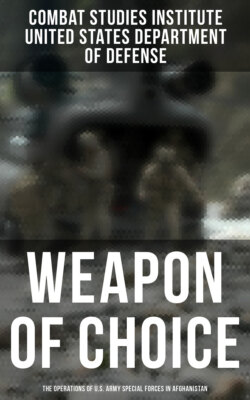Читать книгу Weapon of Choice: The Operations of U.S. Army Special Forces in Afghanistan - Combat Studies Institute - Страница 9
На сайте Литреса книга снята с продажи.
“Subdue Without Fighting”: JPOTF, MacDill Air Force Base, Florida
Оглавление“To win one hundred victories in one hundred battles is not the acme of skill. To subdue the enemy without fighting is the acme of skill.” So spoke ancient Chinese philosopher Sun Tzu around 500 B.C. Rare is the war in which no fighting occurs, but many are the wars in which PSYOP is employed to minimize the degree of fighting. The war in Afghanistan was but the latest war in which PSYOP was used to convince the Taliban, the al-Qaeda, and its people that resistance to coalition forces was not only futile but also detrimental to the future welfare of the nation. Coordinating that PSYOP effort was the Joint Psychological Operations Task Force (JPOTF) located at the U.S. Central Command (CENTCOM), MacDill Air Force Base, Florida. The JPOTF commander was Lieutenant Colonel (LTC) Sam Halstedt (pseudonym), commander of the 8th Psychological Operations Battalion (POB), 4th Psychological Operations Group (POG), U.S. Army Special Operations Command (USASOC).
Figure 18. Resistance is futile; assistance works better.
Figure 19. “Reassurance” leaflets in multiple languages.
Few soldiers outside the PSYOP military specialty had heard of a JPOTF. A unified combatant command can create such a task force “as a separate functional component of the combatant commander.” When established, the JPOTF normally is under the theater commander’s operational control. Tactical PSYOP units are then attached to ground maneuver commanders. The mission of a JPOTF is to provide “PSYOP support to the overall joint or combined operation at the operational and tactical levels.” To do that, it coordinates requirements with the defense service components based on mission requirements. The command becomes joint when members of several services form the organization.
Following doctrinal guidelines, in September 2001, CENTCOM, the combatant command, established a JPOTF, the nucleus of which was the 8th POB staff. The JPOTF mission was to conduct operational and tactical PSYOP to isolate terrorists from their support systems and to strengthen resolve between the allies and the people of Afghanistan to eliminate those terrorists. The 8th POB formed the nucleus of the JPOTF because of its war trace alignment with CENTCOM, just as other PSYOP battalions are aligned with other regional combatant commanders.
Halstedt was an experienced soldier. During Operation DESERT STORM in 1991, he commanded a Special Forces ODA and served in the 75th Ranger Regiment. He knew how to plan and how to get things done, and he also knew that because PSYOP attracted great interest at DOD level, everything the JPOTF did would be subject to media scrutiny. But Halstedt had a mission, and defining the scope of that mission was his first task. He knew that PSYOP must support the overall war campaign plan. The more the JPOTF and the PSYOP soldiers on the ground could influence enemy soldiers to surrender, the less fighting Special Forces and conventional soldiers would have to face. Halstedt also knew that support from the populace was key. His plan, therefore, had to include the people.
Figure 20. Leaflet messages directed at the civilian population.
On 14 September 2001, Halstedt and a staff of four reported to CENTCOM headquarters. Based on careful examination of the region and the culture, the JPOTF cadre, military planners, and civilian experts developed several themes. The first objective was to produce anti-Taliban and anti-al-Qaeda material that would persuade the Afghan people to reject their legitimacy. Simultaneously, the planners proposed themes to demonstrate that the coalition forces were there to assist the people in overthrowing their oppressors and to provide humanitarian aid. The group also knew that at some point in the ground campaign the coalition forces would sponsor reconstruction efforts and that some form of legitimate government would need to be created. It was critical for the Afghan people to understand that the government would be of their choosing, not the United States’ or any other members of the coalition.
With these themes and objectives in mind and having coordinated their plan with the overall campaign plan, Halstedt forwarded the proposed CENTCOM PSYOP plan to the Pentagon for approval. Military officials in the Office of the Joint Chiefs of Staff (OJCS) reviewed it and then sent it to the Office of the Secretary of Defense (OSD). At OSD, the Assistant Secretary of Defense for Special Operations and Low-Intensity Conflict (ASD-SO/LIC) and the Under Secretary of Defense for Policy (USD-P) reviewed and approved the draft. OJCS then gave CENTCOM approval to implement the plan. As the war in Afghanistan progressed, the approval process for PSYOP products would be modified. During the first month of the war, all PSYOP products were approved at OSD, but beginning in November 2001, Franks, as combatant commander, CENTCOM, assumed that authority.
Figure 21. Leaflet appealing to Afghan nationalism.
Figure 22. 4th POG printing presses regularly operated overtime.
While the approval process was under way, the JPOTF began to fill its staff. From the initial 120 from 8th POB, it grew to 313 personnel. About one-third of the staff was reservists activated for Operation ENDURING FREEDOM (OEF). The JPOTF coordinated with Air Force personnel who advised on using the EC-130 Commando Solo aircraft. One U.S. Navy officer coordinated PSYOP support for maritime operations. Because the preponderance of PSYOP assets was Army, the staff was predominantly Army personnel. Two coalition liaison officers coordinated PSYOP support to military forces from other nations.
Although SOCCENT tactically controls SOF for the CENTCOM commander and PSYOP units are SOF, the combatant command, CENTCOM, directly controlled the JPOTF. The JPOTF commanded all PSYOP forces, but JSOTF-North would eventually tactically control them. While the leaders understood these organizational lines, the funding for the PSYOP units was unclear. The issue of whether USSOCOM funded the sustainment costs of deployed SOF had to be resolved. Funding issues, like foreign repairs of printing presses, were overcome.
